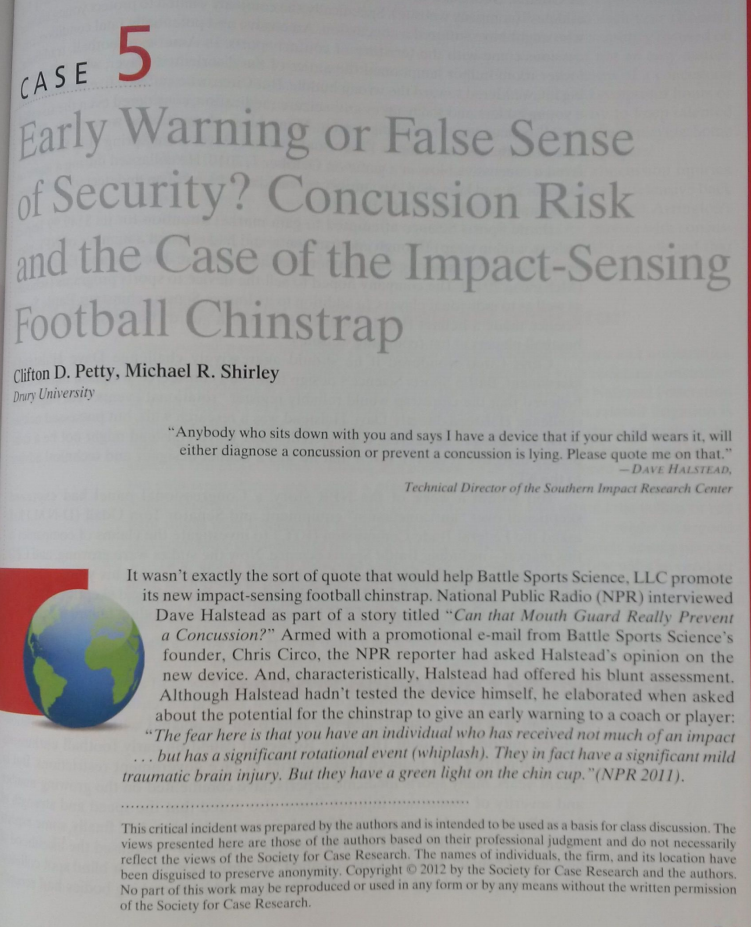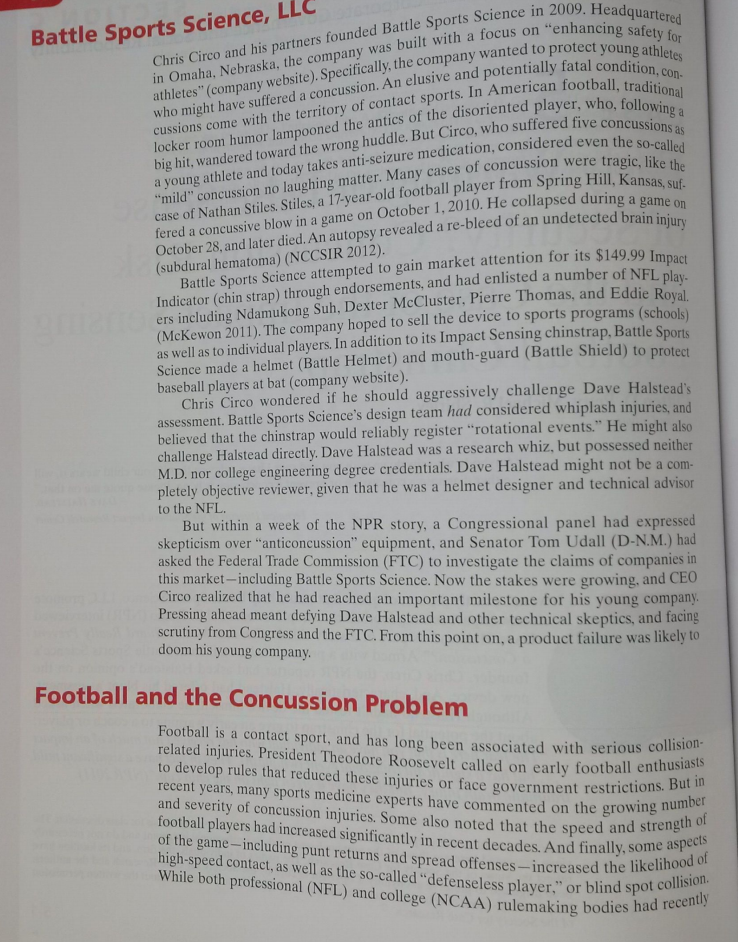Need help creating SWOT analysis for this case "Early Warnings or False Sense of Security? Concussion Risk and the Case of the Impact-Sensing Football Chinstrag"
CASE 5 Early Warning or False Sense of Security? Concussion Risk and the Case of the Impact-Sensing Football Chinstrap Clifton D. Petty, Michael R. Shirley Drury University "Anybody who sits down with you and says I have a device that if your child wears it, will either diagnose a concussion or prevent a concussion is lying. Please quote me on that." - DAVE HALSTEAD, Technical Director of the Southern Impact Research Center It wasn't exactly the sort of quote that would help Battle Sports Science, LLC promote its new impact-sensing football chinstrap. National Public Radio (NPR) interviewed Dave Halstead as part of a story titled "Can that Mouth Guard Really Prevent a Concussion?" Armed with a promotional e-mail from Battle Sports Science's founder, Chris Circo, the NPR reporter had asked Halstead's opinion on the new device. And, characteristically, Halstead had offered his blunt assessment. Although Halstead hadn't tested the device himself, he elaborated when asked about the potential for the chinstrap to give an early warning to a coach or player: "The fear here is that you have an individual who has received not much of an impact . . . but has a significant rotational event (whiplash). They in fact have a significant mild traumatic brain injury. But they have a green light on the chin cup. "(NPR 2011). This critical incident was prepared by the authors and is intended to be used as a basis for class discussion. The views presented here are those of the authors based on their professional judgment and do not necessarily reflect the views of the Society for Case Research. The names of individuals, the firm, and its location have been disguised to preserve anonymity. Copyright @ 2012 by the Society for Case Research and the authors. No part of this work may be reproduced or used in any form or by any means without the written permission of the Society for Case Research.Battle Sports Science, LLC Chris Circo and his partners founded Battle Sports Science in 2009. Headquartered in Omaha, Nebraska, the company was built with a focus on "enhancing safety for athletes" (company website). Specifically, the company wanted to protect young athletes who might have suffered a concussion. An elusive and potentially fatal condition, con- cussions come with the territory of contact sports. In American football, traditional locker room humor lampooned the antics of the disoriented player, who, following a big hit, wandered toward the wrong huddle. But Circo, who suffered five concussions as a young athlete and today takes anti-seizure medication, considered even the so-called "mild" concussion no laughing matter. Many cases of concussion were tragic, like the case of Nathan Stiles. Stiles, a 17-year-old football player from Spring Hill, Kansas, suf- fered a concussive blow in a game on October 1, 2010. He collapsed during a game on October 28, and later died. An autopsy revealed a re-bleed of an undetected brain injury (subdural hematoma) (NCCSIR 2012). Battle Sports Science attempted to gain market attention for its $149.99 Impact Indicator (chin strap) through endorsements, and had enlisted a number of NFL play- ers including Ndamukong Suh, Dexter McCluster, Pierre Thomas, and Eddie Royal. (McKewon 2011). The company hoped to sell the device to sports programs (schools) as well as to individual players. In addition to its Impact Sensing chinstrap, Battle Sports Science made a helmet (Battle Helmet) and mouth-guard (Battle Shield) to protect baseball players at bat (company website). Chris Circo wondered if he should aggressively challenge Dave Halstead's assessment. Battle Sports Science's design team had considered whiplash injuries, and believed that the chinstrap would reliably register "rotational events." He might also challenge Halstead directly. Dave Halstead was a research whiz, but possessed neither M.D. nor college engineering degree credentials. Dave Halstead might not be a com- to the NFL. pletely objective reviewer, given that he was a helmet designer and technical advisor But within a week of the NPR story, a Congressional panel had expressed skepticism over "anticoncussion" equipment, and Senator Tom Udall (D-N.M.) had asked the Federal Trade Commission (FTC) to investigate the claims of companies in this market-including Battle Sports Science. Now the stakes were growing, and CEO Circo realized that he had reached an important milestone for his young company. Pressing ahead meant defying Dave Halstead and other technical skeptics, and facing scrutiny from Congress and the FTC. From this point on, a product failure was likely to doom his young company. Football and the Concussion Problem Football is a contact sport, and has long been associated with serious collision- related injuries. President Theodore Roosevelt called on early football enthusiasts to develop rules that reduced these injuries or face government restrictions. But in recent years, many sports medicine experts have commented on the growing number and severity of concussion injuries. Some also noted that the speed and strength of football players had increased significantly in recent decades. And finally, some aspects of the game-including punt returns and spread offenses -increased the likelihood of high-speed contact, as well as the so-called "defenseless player," or blind spot collision. While both professional (NFL) and college (NCAA) rulemaking bodies had recentlyCASE 5 Early Warning or False Sense of Security? 5-3 focused attention on reducing the growing number and severity of traumatic brain injuries, by far the most extensive risk existed at the high school level. According to the National Federation of State High School Associations, some 1.14 million students annually participated in high school football. Approximately 9%, or at least 140,000 of these young athletes, suffered a concussion each year (Koester 2010). Training programs for high-school football coaches were increasingly focused on concussion recognition. But identification of a player at risk was not an easy matter. According to the Centers for Disease Control (CDC), the symptoms of a concussion were sometimes subtle and athletes often experienced or reported symptoms hours or even days after the concussive event (HHS). Coaches felt pressure to keep talented players on the field, and players often hid their symptoms in order to keep playing. Some high school players took their cues in this regard from professional players: Both the NFL and NCAA have been sued by players over concussion injuries. A suit was filed against the NCAA on behalf of former Eastern Illinois defensive back Adrian Arrington, 25, who had several concussions between 2006 and 2009. Arrington's suit alleged that the NCAA didn't "set up sufficient guidelines for players with concus- sions" (Hailey). In addition, 75 former NFL players filed suit in 2010 and alleged that the NFL hid the dangers of concussions from players intentionally (Fendrich 2010). Responsibility and the Impact Indicator Some recent trends, including the litigation against football leagues and universities, suggest a role for Battle Sports Science's Impact Indicator in both reducing concussive injuries and litigation risk for football organizations and schools. The National Federation of High School (NFHS) has alerted its members that concussion-related litigation is gathering momentum, and is increasingly targeting coaches and school officials at the high school level (Koester). The Impact Indicator identified potential injuries, and helped coaches and players avoid a subsequent collision to an already injured brain. A light on the chin strap shines green until a player is struck in such a way that a head injury is either possible (yellow light) or likely (red light). A coach who spotted the yellow or red light might then sideline the injured player. From this perspective, it might be argued that aggressive promotion of the Impact Indicator should improve safety among players. Then again, what if Halstead's skepticism was well placed? How will the product have performed in the thousands of complex and high-speed encounters that occur on football fields across the United States? More testing and slower rollout might lower some risk, but it would also provide rivals time to copy the chin strap and beat Battle Science to the market. One thing was certain - the company couldn't stand still now. All the recent publicity- even from critics like Halstead-had pushed the company onto the field with respect to the concussion controversy in football. If Circo had any doubts about his product, it was time to face them before it was too late. Otherwise, it was time to set his strategy for moving forward while managing intense risks and likely controversy









